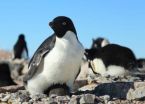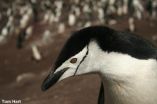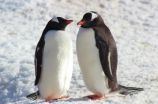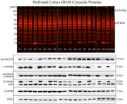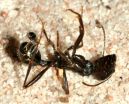(Press-News.org) A study of how penguin populations have changed over the last 30,000 years has shown that between the last ice age and up to around 1,000 years ago penguin populations benefitted from climate warming and retreating ice. This suggests that recent declines in penguins may be because ice is now retreating too far or too fast.
An international team, led by scientists from the Universities of Southampton and Oxford, has used a genetic technique to estimate when current genetic diversity arose in penguins and to recreate past population sizes. Looking at the 30,000 years before human activity impacted the climate, as Antarctica gradually warmed, they found that three species of penguin; Chinstrap, Adélie and southern populations of Gentoo penguins increased in numbers. In contrast, Gentoo penguins on the Falkland Islands were relatively stable, as they were not affected by large changes in ice extent.
A report of the research is published in the journal Scientific Reports.
Lead author of the paper, Gemma Clucas, from Ocean and Earth Sciences at the University of Southampton comments: "Whereas we typically think of penguins as relying on ice, this research shows that during the last ice age there was probably too much ice around Antarctica to support the large populations we see today. The penguins we studied need ice-free ground to breed on and they need to be able to access the ocean to feed. The extensive ice-sheets and sea ice around Antarctica would have made it inhospitable for them.
"What is particularly interesting is that after the ice age, all of these penguin populations were climate change 'winners', that is to say the warming climate allowed them to expand and increase in number. However, this is not the pattern we're seeing today. Adélie and Chinstrap penguins appear to be declining due to climate change around the Antarctic Peninsula, so they've become 'losers'. Only the Gentoo penguin has continued to be a 'winner' and is expanding its range southward."
Dr Tom Hart of the University of Oxford's Department of Zoology, an author of the paper, continues: "We are not saying that today's warming climate is good for penguins, in fact the current decline of some penguin species suggests that the warming climate has gone too far for most penguins.
"What we have found is that over the last 30,000 years different penguin species have responded very differently to a gradually warming world, not something we might expect given the damage current rapid warming seems to be doing to penguins' prospects."
To estimate changes in penguin genetic diversity, the researchers collected feathers and blood samples from 537 penguins in colonies around the Antarctic Peninsula. The scientists then sequenced a region of mitochondrial DNA that evolves relatively quickly. Using the rate of mutation of this region of DNA as a calibration point, the researchers were able to chart how the size of these populations has varied over time. The team working on the project included scientists from the British Antarctic Survey and also US scientists from Oceanites Inc, Woods Hole Oceanographic Institution, and the University of North Carolina, Wilmington.
"During the last ice age Antarctica was encircled by 100 per cent more winter sea ice than today," says Dr Tom Hart. "As ice retreated, these penguins had access to more breeding sites and more open ocean to feed."
Gemma Clucas, who is based at the National Oceanography Centre, Southampton, says: "Despite historic warming clearly opening up new opportunities for penguins, we should not assume that current rapid warming caused by human activity is good for penguins as a whole. Evidence from other studies shows that climate change today is creating lots of losers and few winners – with chinstrap and Adélie populations around the Antarctic Peninsula declining fast. This is probably as a result of reductions in sea ice causing stocks of the krill they feed on to shrink, whilst populations of Gentoo penguins, which don't rely on krill as much, grow and expand."
INFORMATION:
Rise and fall of prehistoric penguin populations charted
2014-06-12
ELSE PRESS RELEASES FROM THIS DATE:
A picture's worth a thousand words
2014-06-12
For nearly 100 years, we have known that type 1 diabetes (T1D) is a disease fundamentally about the progressive loss of insulin-producing beta cells, but measuring that loss has continued to elude researchers—at least until now.
In a recent scientific publication, JDRF-funded researchers used a radiotracer or marker and PET (Positron Emission Tomography) scanning as a non-invasive technique to follow changes in how many active beta cells a person has. Dr. Olle Korsgren and his colleagues at the University of Uppsala in Sweden used the technique in a clinical study ...
Alcohol abuse damage in neurones at a molecular scale identified for first time
2014-06-12
This news release is available in Spanish.
Joint research between the University of the Basque Country (UPV/EHU) and the University of Nottingham has identified, for the first time, the structural damage caused at a molecular level to the brain by the chronic excessive abuse of alcohol. In concrete, the research team has determined the alterations produced in the neurones of the prefrontal zone of the brain (the most advanced zone in terms of evolution and that which controls executive functions such as planning, designing strategies, working memory, selective ...
David and Goliath: How a tiny spider catches much larger prey
2014-06-12
In nature, it is very rare to find a proverbial much smaller David able to overpower and kill a Goliath for supper. This is exactly the modus operandi of a solitary tiny spider from the Negev desert in Israel that routinely kills ants up to almost four times its own size. Details about how it attacks and kills its prey with a venomous bite is published in Springer's journal Naturwissenschaften – The Science of Nature. The study was led by Stano Pekár of Masaryk University in the Czech Republic.
Pekár's team observed the natural prey and predatory behavior of the minute ...
Survivors of childhood liver transplant at risk of becoming 'skinny fat'
2014-06-12
New research reports that survivors of childhood liver transplant remain nutritionally compromised over the long-term. Findings published in Liver Transplantation, a journal of the American Association for the Study of Liver Diseases and the International Liver Transplantation Society, indicate that the recipients' return to normal weight post-transplant was due to an increase in fat mass as body cell mass remained low, indicating a slim body composition with little lean muscle mass or "skinny fat."
Children with end-stage liver disease may be malnourished due to inadequate ...
Scientists closing in on new obesity drug
2014-06-12
Obesity and diabetes are among the fastest growing health problems in the world, and the hunt is in for a pill that can fight the problem. Now a Danish/British team has come up with a smart tool that will speed up the scientific hunting process, and we may be one step closer to a pill against obesity.
The body has a variety of functions that decide if we get overweight or not. For instance hormones control our appetite and the uptake of food. In recent years science has taken on the quest of investigating these physiological functions and finding a medical way to fight ...
Children showing signs of social withdrawal in risk of internalized distress
2014-06-12
Children are showing signs of social withdrawal are more susceptible to parental influences than others. These children were also more prone to distress caused by the impacts of guilt-inducing parenting.
The researchers of the University of Jyväskylä, Finland, have found that children showing signs of social withdrawal are more susceptible to parental influences than others. The researchers followed up about 300 children across the first three years of primary school and monitored the children's social skills and problem behaviors. At the same time, mothers' and fathers' ...
Recreational football can treat hypertensive and type 2 diabetes patients
2014-06-12
The studies, published in the acclaimed Scandinavian Journal of Medicine & Science in Sports, show that 24 weeks of twice-weekly recreational football training sessions lower blood pressure and improves heart function in men with high blood pressure and men with type 2 diabetes. Furthermore, men with type 2 diabetes lost 12 % of their abdominal fat and reduced their blood sugar 20% more than inactive control subjects.
These effects are likely to reduce the risk of developing heart diseases including heart failure and myocardial infarction, and the participants had a reduced ...
Does food addiction exist?
2014-06-12
Women with weight problems were more impulsive than average in a food-related psychology test, a new research paper has shown. This suggested that they are more instinctively stimulated by images of food as well as lacking contemplative will power. Further, some women reported food craving even if they had eaten recently, a symptom of possible food addiction.
"All addictions are similar in that the sufferer craves to excess the feel-good buzz they receive from chemical neurotransmitters produced when they eat, gamble, smoke, have sex or take drugs," commented Claus Voegele, ...
Blood product sterilization taken too far?
2014-06-12
Certain processes used to sterilize blood products could potentially cause serious health issues in transfusion recipients, according to an international study published in the journal Platelets and led by Dr. Patrick Provost of Université Laval's Faculty of Medicine and the CHU de Québec Research Center. These processes purportedly alter the blood platelets to the extent of preventing them from carrying out their functions correctly and may be the cause of hemorrhages observed in patients having received treated blood.
The function of platelets goes far beyond their ...
When good people do bad things
2014-06-12
CAMBRIDGE, MA -- When people get together in groups, unusual things can happen — both good and bad. Groups create important social institutions that an individual could not achieve alone, but there can be a darker side to such alliances: Belonging to a group makes people more likely to harm others outside the group.
"Although humans exhibit strong preferences for equity and moral prohibitions against harm in many contexts, people's priorities change when there is an 'us' and a 'them,'" says Rebecca Saxe, an associate professor of cognitive neuroscience at MIT. "A group ...
